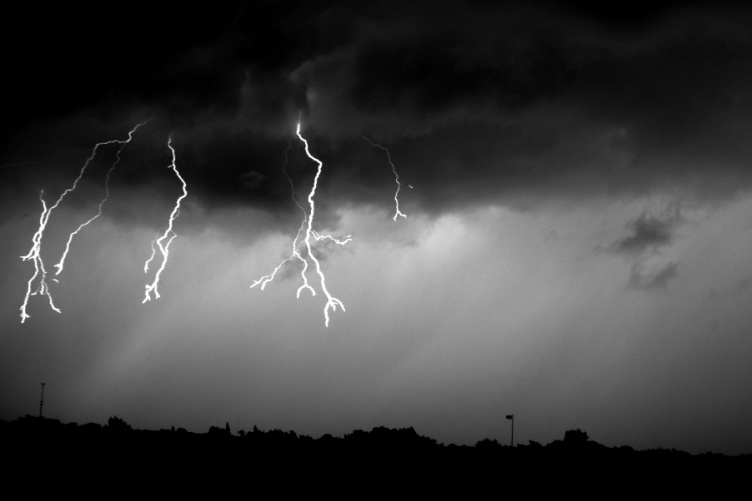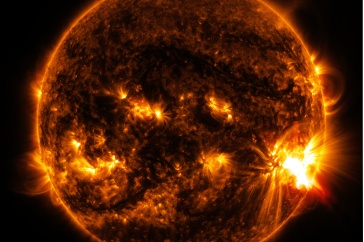
Lightning, like this flash recorded at the Kennedy Space Center in Florida, starts deep inside a cloud. In their study, UNH researchers observed a possible new way that lightning forms called "fast negative breakdown."
In a first-of-its-kind observation, researchers from the University of New Hampshire have documented an unusual phenomenon that occurs in the clouds before a lightning flash emerges.
Their observation of “fast negative breakdown” challenges the prevailing scientific view of how air electrically breaks down to carry electricity in thunderstorms. This finding is likely to open up a new realm of research for lightning scientists.
“Fast negative breakdown is an unexpected subprocess associated with lightning and we’re just getting little pieces of the bigger picture of how lightning begins and spreads,” says Julia Tilles, a Ph.D. candidate in the UNH Space Science Center and lead author on the study that was published in Nature Communications.
When the electrical charges in a cloud are gearing up before a lightning flash, they are separated into layers — typically with a positively charged layer higher up in the cloud and a negatively charged layer in the middle of the cloud. Air is not usually a good conductor of electricity at thunderstorm altitudes, but when the electric field between those two layers becomes sufficiently strong, the air electrically breaks down. This creates a pathway for electricity to flow and then defuse the charges between the layers within the cloud.

researchers from UNH and New mexico tech installed ground-based antennas to investigate how lightning starts in the clouds. photo by Julia tilles.
For decades, scientists have thought this pathway would initially develop in a downward direction, moving from the positive charge at the top of the cloud down to the negative charge in the middle of the cloud. Scientists confirmed this theory a few years ago with the discovery of “fast positive breakdown” of air that moves at one-fifth the speed of light and can initiate a lightning flash. However, the reported observation of fast negative breakdown, which is equally speedy but creates the pathway in the opposite direction — that is, upward in the cloud — indicates there’s another way to start electricity in the air. Ultimately, this provides scientists with a counterview of what’s possible inside a storm cloud.
“These findings indicate that lightning creation within a cloud might be more bidirectional than we originally thought,” Tilles says.
In collaboration with a lightning research team from New Mexico Institute of Mining and Technology, Tilles documented fast negative breakdown in a Florida lightning storm using radio waves originating deep inside the storm clouds. An array of ground-based antennas picked up the radio waves, which then allowed researchers to create a highly detailed image of the radio sources and identify this unusual phenomenon.
"These are glimpses of things no one has ever seen before, and they’re fascinating."
“Right now, we don’t have a good explanation for why fast negative breakdown occurs,” says Ningyu Liu, UNH professor of physics and a co-author on the study. “It’s really puzzling because the electrical breakdown that develops in a downward direction is easier to initiate than this new observation of upward direction. But this is the first time it has ever been observed, so it’s very exciting.”
It’s still too early to tell how often fast negative breakdown events occur or what fraction of them can initiate an actual lightning flash, but researchers have plenty of data they can comb through in the coming months to see if they can learn more about fast negative breakdown.
“Every time I develop an image from the data, we find something totally new,” Tilles says. “These are glimpses of things no one has ever seen before, and they’re fascinating.”
Funding for this research was provided by the National Science Foundation and the Air Force Office of Scientific Research. Find out more about lightning research, facts, and safety.
The Institute for the Study of Earth, Oceans, and Space (EOS) is UNH’s largest research enterprise, comprising five centers with a focus on interdisciplinary, high-impact research on Earth and climate systems, space science, the marine environment and seafloor mapping. With more than $43 million in external funding secured annually, EOS fosters an intellectual and scientific environment that advances visionary scholarship and leadership in world-class research and graduate education.
-
Written By:
Rebecca Irelan | Institute for the Study of Earth, Oceans, and Space | rebecca.irelan@unh.edu | 603-862-0990



















































